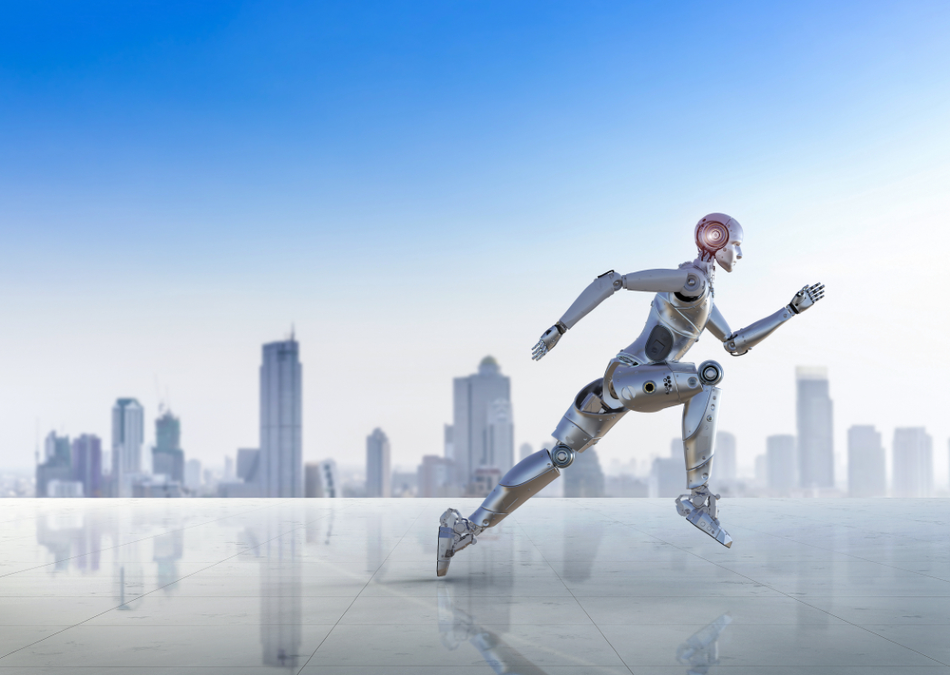By Kalwinder KaurNov 4 2012

Image Credit: Phonlamai Photo/Shutterstock.com
Running robots that display a natural gait is an exciting field of research and development that has progressed tremendously since Honda unveiled ASIMO in 2000. In a way like how a human body works during movement, energy is stored at each tread and released - stored energy allows the muscle tissue to contract and force a change in the posture of the limb. The ARL Monopod II from 1998 was an early example of a robot with a remarkable mechanical design based on natural dynamics - it could hop even when the power was turned off.
ATRIAS 1.0 - Hopping Around Room
Video Source: Dynamic Robotics Laboratory/YouTube.com
ASIMO was the first robot to walk on two legs and was designed by Honda, thus leading the way in research for humanoid robots. It was “retired” by Honda in 2018 after a career that included, playing soccer with President Obama, winning over Kelly Ripa on TV in 2014 and also had some clumsy moments like a particularly awful fall while trying to walk up a flight of stairs early in its development. ASIMO was developed for operations in real-time that include climbing stairs, navigating sidewalks and floors and searching for things, making this humanoid robot essential for its application to assist in care-homes, or in social situations where resources are few.
One aim of the humanoid robot concept is to make them tactile to allow easy interaction with humans. Aesthetically, a running robot should mimic that of a human body when in motion (i.e., fluidic movement not only looks less alien to the observer, but this is also when robots will start to become an interesting and engaging addition to the human world).
ASIMO was designed with 34 degrees of freedom with integrated force sensors on its wrists that allow it to measure the strength and force applied to the hand structure. Smooth walking can be achieved by combining turning, steady speed, deceleration and stored walking patterns for acceleration - all functional capabilities possible with multiple degrees of freedom. Complex tasks like climbing up and down the stairs and navigation of slope can be accomplished using Intelligent Real-Time Flexible Walking (or i-WALK).
ASIMO maintained balance by bending or twisting its torso using Posture Control technology, sophisticated instrumentation that became increasingly more attractive to researchers in the field of humanoid robotics. ASIMO was also capable of changing its direction automatically having identified an obstacle by the visual or ground sensor in its path.
Atlas
The current leader in the field seems to be Atlas from Boston Dynamics who were bought from Alphabet by Japan’s SoftBank in 2017. Claimed to be the world’s most dynamic robot, Atlas has one of the world’s most compact mobile hydraulic systems. Custom motors, valves, and a compact hydraulic power unit enable the delivery of power to any of its 28 hydraulic joints. Weighing in at just 80 kilos at 1.5 m, Atlas uses 3D printed parts to give it the strength-to-weight ratio necessary for leaps and somersaults. In September 2019 Boston Dynamics released a video that showed just how far Atlas has developed since the early demonstrations of a tethered robot running through a forest. The robot now has enough processing power to navigate and jog and jump across significant obstacles showing unprecedented levels of balance and navigation. Not as cute as ASIMO but more athletic.
Spot
BigDog was a rough-terrain robot developed by Boston Dynamics, designed to demonstrate speed, autonomy, and great mobility to enhance its performance in testing environments. Although impressive and somewhat scary, Big Dog was considered too noisy for Military use and its technology morphed into Spot (originally Spot mini) a compact smarter robot dog. Spot is a versatile robot with interchangeable capability modules, great dance moves and potential for use in real-world situations. If it’s checking for gas, you can use a detector. If you need connectivity over a long distance, you can attach a radio module. However, despite what it looks like in the videos, Spot isn’t autonomous, it’s essentially a remote control device with the user as the brains behind Spot, once you start to add in AI to these robots things could get very scary very quickly.
HUBO 2 plus
The Korea Advanced Institute of Science and Technology (KAIST) humanoid robot - 3 (KHR-3) (HUBO) has human-friendly character, several movements and human-like features. The current version weighs 43kg and is 130 cm tall. HUBO 2 plus was developed based on KHR-2 and has a detailed frame design and greater stiffness than KHR-2. It has 38 degrees of freedom and two types of gears, namely, harmonic and planetary for the movement of joints. The latest iteration of the robot is the HUBO 2 plus. A HUBO was the winner of the DARPA Robotics Challenge finals on June 6, 2015. DRC-Hubo is a multifunctional device that can transform from a walking robot to rolling on 4 wheels by bending and using wheels incorporated into its knees. One of the tasks was to climb stairs, which the DRC-Hubo was able to do by transforming into its walking posture.
Sources and Further Reading
- https://www.bostondynamics.com/spot
- https://www.bostondynamics.com/atlas
- ASIMO - http://asimo.honda.com/inside-asimo/
- Park.I.W, Kim.J.Y, Lee.J, Department of Mechanical Engineering, Korea Advanced Institute of Science and Technology, South Korea, Advanced Robotics.
- Hurst.J.W, 2008, The Role and Implementation of Compliance in Legged Locomotion, Robotics Institute, Pennsylvania.
This article was updated on 4th March, 2020.
Disclaimer: The views expressed here are those of the author expressed in their private capacity and do not necessarily represent the views of AZoM.com Limited T/A AZoNetwork the owner and operator of this website. This disclaimer forms part of the Terms and conditions of use of this website.